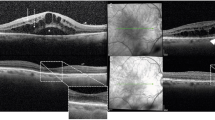Abstract
THE aqueous flare is a scattering phenomenon, which may be observed when a beam of light passes the anterior chamber of the eye. It is caused by the presence of substances with large molecules (proteins). Using a photographic apparatus1 for measuring the intensity of the flare, Anjou, Krakau and Stigmar2 observed that an injection of chromatographically pure preparations of ACTH may cause an increase, sometimes quite impressive, of the flare density in normal eyes of rabbits. The maximum density occurred about 3 h after the injection; then the flare intensity faded slowly. The flare effect was regularly accompanied by a reduction of the intraocular pressure. No effect could be seen after vasopressin.
This is a preview of subscription content, access via your institution
Access options
Subscribe to this journal
Receive 51 print issues and online access
$199.00 per year
only $3.90 per issue
Buy this article
- Purchase on SpringerLink
- Instant access to full article PDF
Prices may be subject to local taxes which are calculated during checkout
Similar content being viewed by others
References
Anjou, C. I. N., and Krakau, C. E. T., Acta Ophthalmol., 38, 174 (1960).
Anjou, C. I. N., Krakau, C. E. T., and Stigmar, G., Acta Ophthalmol., 39, 874 (1961).
Dyster-Aas, K., and Krakau, C. E. T., Ophthalmol. (in the press).
Author information
Authors and Affiliations
Rights and permissions
About this article
Cite this article
DYSTER-AAS, K., KRAKAU, C. Effect of Melanocyte-stimulating Hormone on the Eye of the Rabbit. Nature 199, 76 (1963). https://doi.org/10.1038/199076a0
Issue date:
DOI: https://doi.org/10.1038/199076a0



